场景
Retrofit2
Retrofit 是对 OkHttp 的封装,是主流的网络框架。
适用于Android 和 Java 的类型安全的HTTP客户端,由Square提供的。
Retrofit是一种HTTP客户端框架,使用它,我们可以完成有关HTTP的工作。
Retrofit Github 主页:
https://github.com/square/Retrofit
注:
博客:
https://blog.csdn.net/badao_liumang_qizhi
关注公众号
霸道的程序猿
获取编程相关电子书、教程推送与免费下载。
实现
导入依赖
在build.gradle中添加依赖
//Retrofit(网络请求框架) implementation 'com.squareup.retrofit2:retrofit:2.5.0' implementation 'com.squareup.retrofit2:converter-gson:2.5.0'
添加位置

然后点击右上角的Sync now
注意:这里不能导入OkHttp与Gson,Retrofit内部已经包含这两个框架,否则会导致版本冲突。
打卡网络权限
在AndroidManifest中添加网络权限。
<uses-permission android:name="android.permission.INTERNET" />
搭建Http客户端
为了在调用接口时方便我们新建一个单例模式的类WebClient去构造Retrofit的实例
在src下包路径下新建web包,包下新建webclient类
package com.badao.badaoimclient.web; import android.util.Log; import retrofit2.Retrofit; import retrofit2.converter.gson.GsonConverterFactory; public class WebClient { private static ApiService INSTANCE; private static final String BASE_URL = "http://你的后台服务的ip:8000/"; public static ApiService getInstance() { if (INSTANCE == null) { synchronized (ApiService.class) { if (INSTANCE == null) { INSTANCE = new Retrofit.Builder().baseUrl(BASE_URL).addConverterFactory(GsonConverterFactory.create()).build().create(ApiService.class); Log.i("INSTANCE",BASE_URL); } } } return INSTANCE; } }
这里指定的BASE_RUL就是你后台服务地址的ip+端口号,最后要带一个斜杠。
然后客户端需要返回一个接口类ApiService,这个接口类是自定义的。
新建接口类ApiService
package com.badao.badaoimclient.web; import com.badao.badaoimclient.bean.ImUserBean; import com.badao.badaoimclient.bean.UploadBean; import okhttp3.MultipartBody; import retrofit2.Call; import retrofit2.http.GET; import retrofit2.http.Multipart; import retrofit2.http.POST; import retrofit2.http.Part; public interface ApiService { /*无参GET请求 */ //没有数据就填 '.' 或者 '/' //获取通讯录接口 @GET("system/imuser/listForApp") Call<ImUserBean> getImUserList(); //文件上传接口 @Multipart @POST("/common/upload") Call<UploadBean> upload(@Part MultipartBody.Part file); }
这里接口类中有两个方法,一个是get方法请求数据,一个是post方法上传文件。
先看这里的get请求的接口,接口的返回值ImUserBean是根据服务接口返回的Json数据生成的bean。

怎样根据Json数据生成实体Bean参考如下:
https://blog.csdn.net/BADAO_LIUMANG_QIZHI/article/details/110426851
生成的实体ImUserBean如下
package com.badao.badaoimclient.bean; import com.google.gson.annotations.SerializedName; import java.util.List; public class ImUserBean { private int total; private int code; private Object msg; private List<RowsBean> rows; public int getTotal() { return total; } public void setTotal(int total) { this.total = total; } public int getCode() { return code; } public void setCode(int code) { this.code = code; } public Object getMsg() { return msg; } public void setMsg(Object msg) { this.msg = msg; } public List<RowsBean> getRows() { return rows; } public void setRows(List<RowsBean> rows) { this.rows = rows; } public static class RowsBean { @SerializedName("id") private int idX; @SerializedName("imNum") private String imNumX; @SerializedName("canOnline") private int canOnlineX; public int getIdX() { return idX; } public void setIdX(int idX) { this.idX = idX; } public String getImNumX() { return imNumX; } public void setImNumX(String imNumX) { this.imNumX = imNumX; } public int getCanOnlineX() { return canOnlineX; } public void setCanOnlineX(int canOnlineX) { this.canOnlineX = canOnlineX; } } }
然后真正调用的接口的url就是
上面配置的BASE_URL加上你的接口方法中配置的url
Get接口调用
在需要调用get接口请求数据的地方
//异步请求通讯录 WebClient.getInstance().getImUserList().enqueue(new Callback<ImUserBean>() { @Override public void onResponse(Call<ImUserBean> call, Response<ImUserBean> response) { Log.i("response",response.toString()); if(response.code()==200) { //获取请求的数据并进行后续操作 ImUserBean userBean = response.body(); rowsBeanList = userBean.getRows(); myAdapter = new MyAdapter(rowsBeanList); listView.setAdapter(myAdapter); } } @Override public void onFailure(Call<ImUserBean> call, Throwable t) { Log.i("onFailure",t.toString()); } }); }
通过它的回调方法来获取响应码和响应体。
此后台接口是用SpringBoot写成,后台get接口部分实现
@GetMapping("/listForApp") @ResponseBody public TableDataInfo listGet(ImUser imUser) { startPage(); List<ImUser> list = imUserService.selectImUserList(imUser); return getDataTable(list); }
其中在getDataTable中最终返回
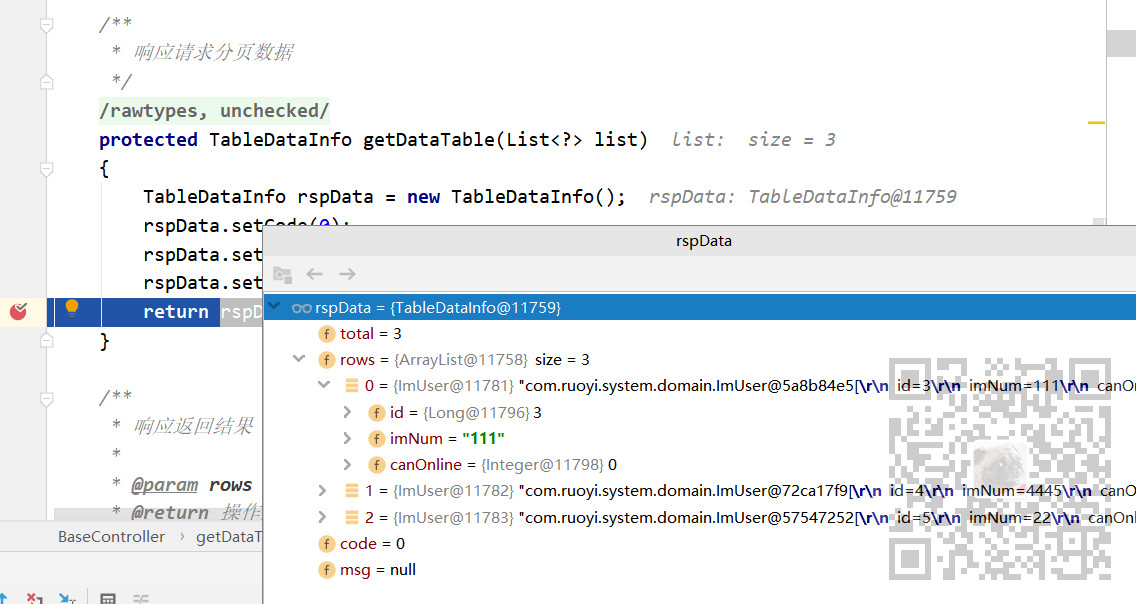
调用一下此接口可以看到其响应码为200

响应体就是上面的json数据
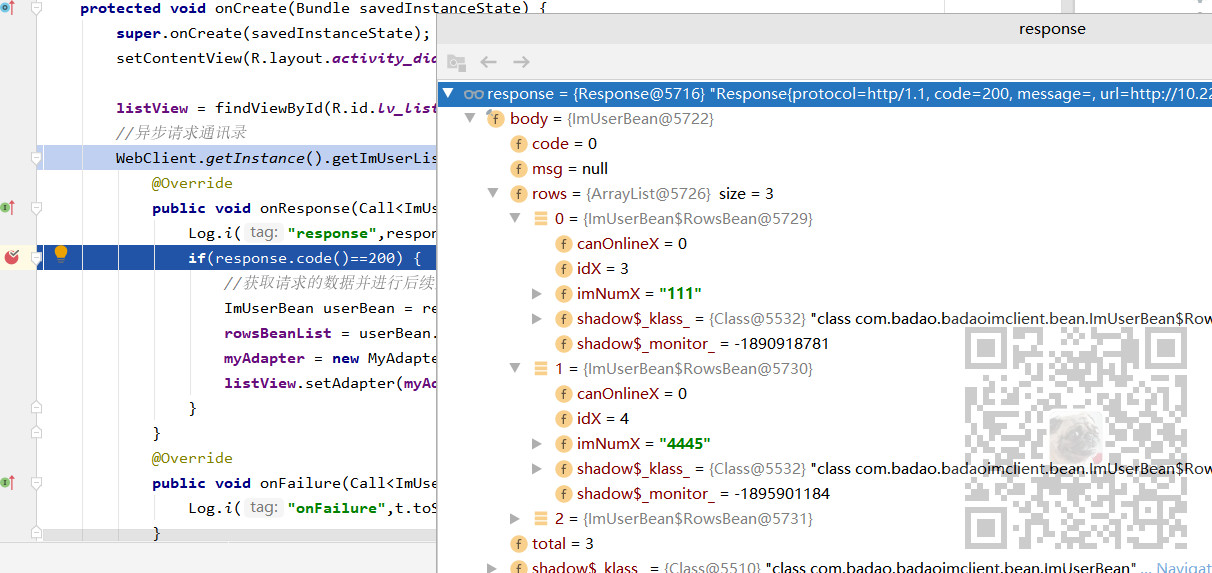
然后可以将get请求的数据通过适配器显示在ListView上
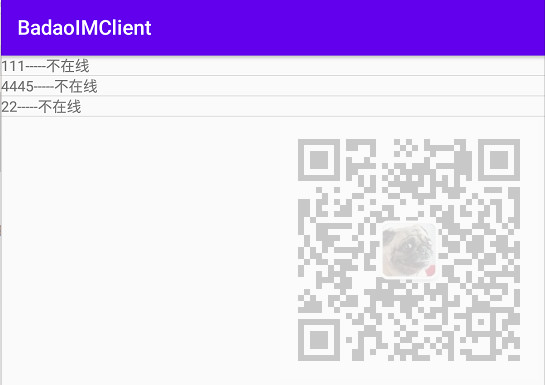
关于适配器的使用参照如下:
https://blog.csdn.net/BADAO_LIUMANG_QIZHI/article/details/111240545
POST请求上传文件
首先在ApiService中添加接口声明
//文件上传接口 @Multipart @POST("/common/upload") Call<UploadBean> upload(@Part MultipartBody.Part file);
然后在需要用到进行文件上传的地方
//上传语音文件到服务器 RequestBody requestBody = RequestBody.create(MediaType.parse("multipart/form-data"), file); MultipartBody.Part part = MultipartBody.Part.createFormData("file", file.getName(), requestBody); WebClient.getInstance().upload(part).enqueue(new Callback<UploadBean>() { @Override public void onResponse(Call<UploadBean> call, Response<UploadBean> response) { if(response.code()==200) { //对服务器地址进行赋值 chatItem.setRemoteContent(response.body().getFileName()); } else { Toast.makeText(App.context,"服务器返回"+response.code(),Toast.LENGTH_SHORT).show(); return; } } @Override public void onFailure(Call<UploadBean> call, Throwable t) { Toast.makeText(App.context,t.toString(),Toast.LENGTH_SHORT).show(); } });
其中file就是需要进行上传的文件,需要构造出一个part对象,然后下面是两个回调方法
触发post方法后,构造part对象成功
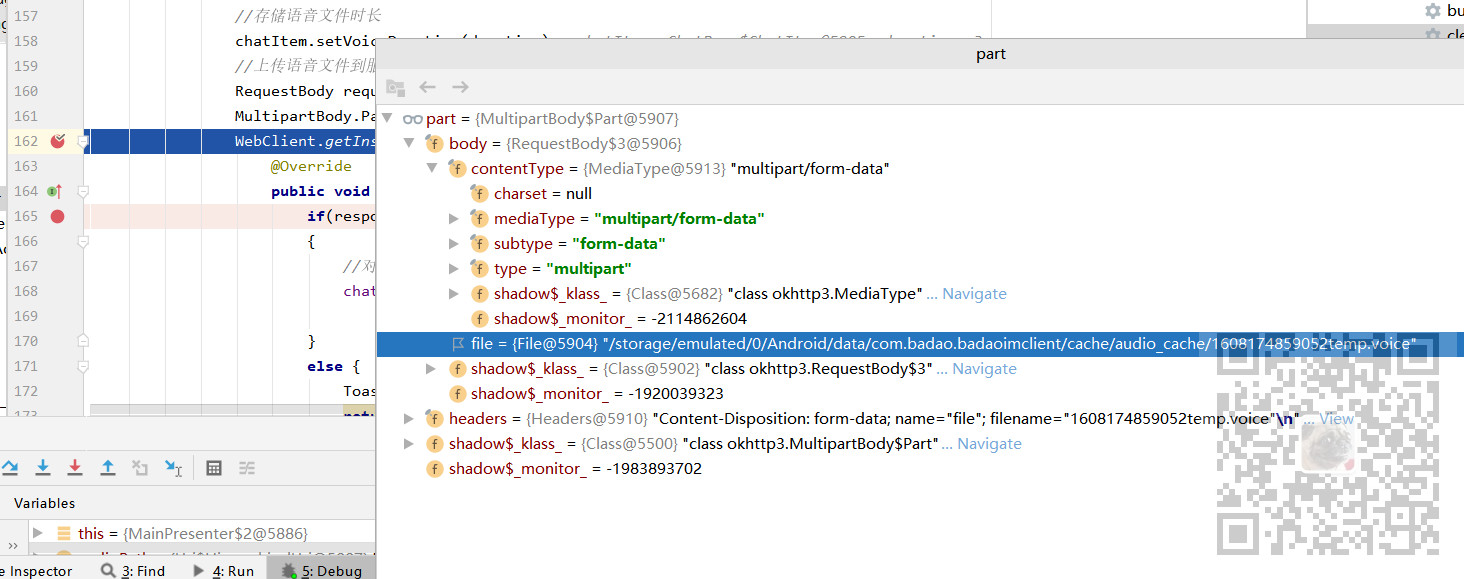
后台使用sprinboot写的post接口
/** * 通用上传请求 */ @PostMapping("/common/upload") @ResponseBody public AjaxResult uploadFile(MultipartFile file) throws Exception { try { // 上传文件路径 String filePath = RuoYiConfig.getUploadPath(); // 上传并返回新文件名称 String fileName = FileUploadUtils.upload(filePath, file); String url = serverConfig.getUrl() + fileName; AjaxResult ajax = AjaxResult.success(); ajax.put("fileName", fileName); ajax.put("url", url); return ajax; } catch (Exception e) { return AjaxResult.error(e.getMessage()); } }
后台接收到请求后
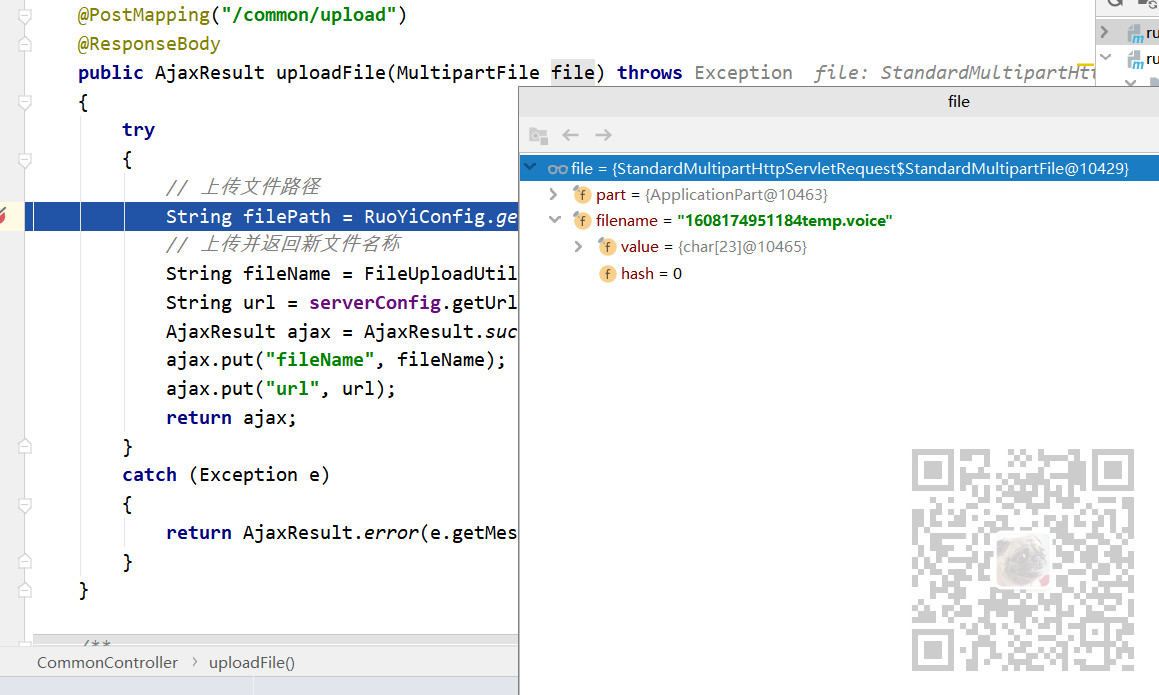
后台返回给Android后
